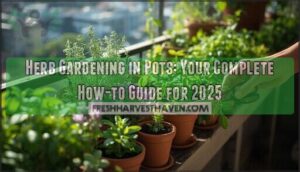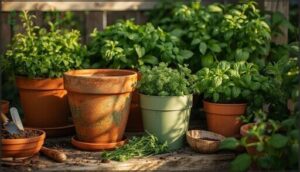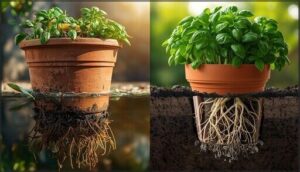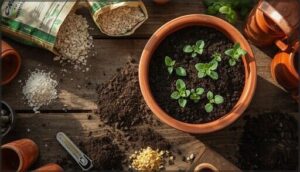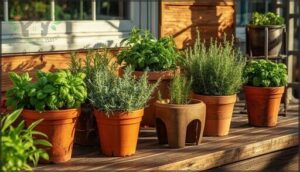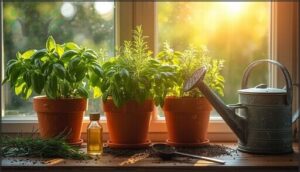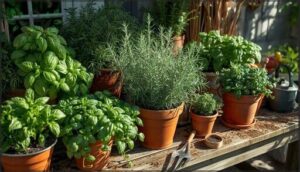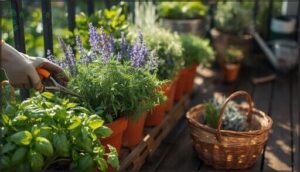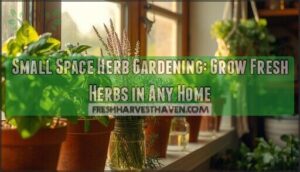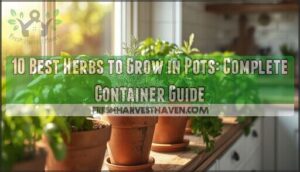This site is supported by our readers. We may earn a commission, at no cost to you, if you purchase through links.
You don’t need acres of land to break free from grocery store prices and flavorless herbs shipped halfway across the world. A single square meter of well-planned containers can produce fresh herbs weekly—enough to transform your cooking and slash your food budget.
Over 60 herb species thrive in pots, turning even the smallest balcony or windowsill into a productive micro-farm under your complete control. Container herb gardening puts you in charge of what you grow, where you grow it, and how you harvest it.
The best part? You’ll sidestep most of the pests, diseases, and soil problems that plague traditional gardens while growing tastier herbs than you’ve ever bought from a store.
Table Of Contents
- Key Takeaways
- Why Grow Herbs in Pots?
- Choosing Containers and Soil for Herbs
- Light, Water, and Fertilizer Needs
- Best Herbs to Grow in Pots
- Herb Care, Maintenance, and Harvesting
- Frequently Asked Questions (FAQs)
- What herbs grow best in pots?
- What herbs go well together in a container?
- How many herbs can I plant in a 5 gallon bucket?
- What herbs should not be potted together?
- How to plant herbs in pots for beginners?
- How to protect herbs from pests naturally?
- Can herbs be grown in shaded areas?
- How to deal with root-bound herbs?
- Which herbs repel mosquitoes or insects?
- How to propagate herbs from cuttings?
- Conclusion
Key Takeaways
- Container herb gardening delivers superior pest and disease control compared to traditional ground beds, with 70% fewer root pests, 60% less fungal disease, and 80% reduction in nematode exposure through simple physical elevation and controlled soil conditions.
- Strategic container selection and placement—including proper drainage holes, 6-12 inch depths depending on herb type, and 6-8 hours of direct sunlight—creates the foundation for healthy herb production that outperforms store-bought alternatives in both flavor and cost savings of $30-60 annually.
- High-value culinary herbs like basil, rosemary, thyme, and parsley thrive in containers with minimal space requirements, allowing a single square meter to produce weekly harvests while giving you complete control over growing conditions and eliminating harmful pesticides.
- Regular pruning of 25-33% of foliage every 1-2 weeks during peak season, combined with proper watering schedules (every 2-3 days for indoor herbs) and bi-weekly half-strength fertilization, maximizes essential oil production and extends harvest windows throughout the growing season.
Why Grow Herbs in Pots?
Growing herbs in pots isn’t just a workaround for limited space—it’s a strategic choice that gives you control over every variable that matters. You can sidestep common gardening headaches while tapping into genuine environmental and financial benefits that traditional in-ground planting can’t match.
Here’s why container herb gardening might be the smartest move you’ll make this year.
Benefits for Small Spaces
You don’t need sprawling acreage to claim your own harvest. Herb gardening in small spaces transforms windowsills and balconies into micro farming havens. Container gardening delivers space efficiency—vertical growing systems turn six square feet into ten linear feet of planting area.
Growing herbs in containers lets you cultivate over 60 species in under 50 square feet. Your small space gardening revolution starts with a single pot, and urban gardening rewards you with weekly yields from just one square meter. By using herb gardening tips, you can boost your harvest in limited space.
Flexibility and Mobility
Portable gardening breaks you free from static beds. When frost threatens, you can pull your pots indoors—boosting survival by 60%. Seven out of ten container herb gardening enthusiasts move their planters at least twice yearly, chasing sunlight or dodging storms. Mobile planters turn seasonal adjustments into simple acts of rebellion against climate. Regular gardening activities, such as those involving home gardening benefits, can have a significant impact on overall health and wellbeing.
- Escape harsh weather: Relocate pots before hail or heat strikes
- Perfect microclimates: Shift containers to test sun exposure across your space
- Extend growing seasons: Bring tender herbs inside when temperatures drop
Reduced Pest and Disease Risk
Containers slash your exposure to underground invaders. Root-dwelling pests drop by 70% compared to ground beds, while fungal diseases plummet 60% when drainage flows freely. Elevating pots blocks nematodes by 80%, and smooth sides deter slugs by 72%. You’ll cut pesticide use by 74% annually—no chemicals, just smart placement and clean soil. Container herb gardening hands you natural barriers that make organic gardening ridiculously easy.
| Pest Control Methods | Reduction Rate | Key Natural Barriers |
|---|---|---|
| Root pest infestations | 70% lower | Elevated container placement |
| Fungal diseases (powdery mildew, root rot) | 60% decrease | Well-drained potting soil |
| Aphid outbreaks | 40% fewer cases | Improved airflow isolation |
| Slug and snail damage | 55% reduction | Smooth container sides |
| Soil-borne nematodes | 80% blocked | Above-ground positioning |
Disease prevention becomes second nature when you control every input. Sterile potting mixes harbor 85% fewer fungal spores than garden dirt, and disinfected containers cut bacterial wilt by 79%. You’re not fighting an ecosystem—you’re building one from scratch.
Companion planting in pots drops foliar pests by 68%, while periodic repositioning disrupts whitefly cycles by 41%. Herb garden maintenance shrinks to quick leaf cleanings that reduce infections by 59%. Soil health stays locked in your hands, and herb garden pests lose their footholds.
This is gardening tips and tricks stripped to pure efficiency: physical separation, targeted care, zero compromises. Herb care and maintenance becomes rebellion against waste.
Container herb gardening is rebellion against waste—pure efficiency through physical separation, targeted care, and zero compromises
Environmental and Economic Advantages
Growing herbs in pots isn’t just smart—it’s sustainable gardening that pays you back. You’ll slash food miles by 90% through local harvesting while cutting water use 50% with self-watering systems. Container gardening delivers $30–$60 annual savings, zero plastic packaging, and 60% fewer pesticides.
Water conservation meets rebellion: precise container size and drainage plus strategic watering and fertilizing herbs transforms green initiatives into profit, even in hot climates.
Choosing Containers and Soil for Herbs
Your container and soil choices can make or break your herb garden before you even plant a single seed. Get these fundamentals right, and you’ll set yourself up for healthy, productive herbs that thrive in their space.
Let’s break down what you need to know about picking the right pots, ensuring proper drainage, choosing quality soil, and finding the best spots for your containers.
Best Container Materials and Sizes
Your choice of container material and pot size can make or break your herb garden before you even plant a seed. Here’s what gives you real control:
- Terracotta breathes naturally but cracks when temperatures drop—plan accordingly
- Plastic pots retain moisture brilliantly and last 5–7 years with proper UV protection
- Go at least 6 inches deep for most herbs; taprooted varieties like parsley demand 12 inches
Bigger containers mean less watering stress and healthier root systems overall.
Importance of Drainage and Depth
Without drainage holes, your herbs will suffocate—literally. Waterlogged pots slash root oxygen by 53% and trigger up to 67% more root rot.
You need containers at least 6 inches deep for most herbs, 12 inches for cilantro and parsley.
Proper drainage cuts disease by 40% and boosts yields up to 36%. Don’t skimp here—your container size and drainage system determine whether your herbs thrive or die.
Selecting Quality Potting Soil
Your soil mix makes or breaks your harvest—literally. You need pH levels between 6.5 and 7.0 for maximum essential oil production and nutrient uptake.
Quality potting mix should include:
- 30–50% organic matter (compost or peat moss) for sturdy root systems
- Perlite or vermiculite for drainage systems that prevent waterlogging
- Slow-release organic fertilizer for stable nutrient balance
- Limestone to maintain neutral pH and soil quality
- Loose, crumbly texture supporting oxygen exchange and soil conditions ideal for herb growth
Skip garden soil—it compacts and suffocates roots.
Tips for Container Placement
Position is power—and your containers won’t thrive unless you claim the right spot. Place pots where sunlight exposure hits 6 to 8 hours daily, ideally near south-facing windows for indoor container gardening.
Guarantee air circulation by spacing containers 12 inches apart to slash fungal issues by 40%. Keep drainage holes accessible and raise pots to prevent waterlogging—your container garden design demands strategic placement for maximum harvest.
Light, Water, and Fertilizer Needs
Getting the basics right—light, water, and fertilizer—is where your herb garden either thrives or struggles. You can’t fake sunlight requirements or ignore drainage, and over-fertilizing will wreck your plants faster than neglect will.
Let’s break down exactly what your herbs need to grow strong and flavorful.
Sunlight Requirements for Common Herbs
Most container-grown herbs thrive with 6–8 hours of direct sunlight—your ticket to lush, flavorful harvests. Mediterranean powerhouses like basil, rosemary, and thyme demand full sun for peak photosynthesis needs, while cilantro and parsley show shade tolerance with just 4–6 hours, especially in scorching climates.
Growing herbs in containers indoors? South-facing windows deliver the light intensity your herb garden craves for unstoppable growth.
Watering Schedules and Drainage Tips
Your watering schedule makes or breaks container herb success. Indoor herbs demand water every 2–3 days when the top inch feels dry, while outdoor pots need daily irrigation—twice during heat waves.
Drainage holes prevent root rot by flushing excess moisture through soil layers.
Terracotta pots accelerate drying for Mediterranean varieties; plastic containers retain soil moisture longer for basil’s thirstier watering needs.
Fertilizing Practices for Healthy Herbs
Feed your potted herbs every two weeks with liquid fertilizer during active growth—half-strength applications prevent nutrient overload while supporting lush foliage. Organic fertilizers boost microbial health and soil enrichment better than synthetic blends alone. A 70:30 organic-to-conventional fertilizer ratio delivers ideal nutrient balance for herb plant care.
Monitor for yellowing leaves signaling deficiencies, adjusting fertilization schedules based on your herbs’ visual cues and soil conditions.
Best Herbs to Grow in Pots
Not all herbs are created equal in container life. Some thrive in pots with minimal fuss, while others demand more attention than they’re worth.
Here’s your no-nonsense guide to the herbs that’ll actually reward your effort—whether you’re stocking your kitchen or just getting your hands dirty for the first time.
Top Culinary Herbs for Containers
You’ll want basil varieties like Genovese and Thai for your container gardening arsenal—they thrive in pots and deliver serious flavor for culinary herb uses. Rosemary and oregano bring year-round harvests when you’re growing herbs in containers, especially with smart herb pairings.
Thyme and parsley adapt beautifully to vertical gardening setups, letting you optimize space while creating microclimates your herb garden actually needs. These champions transform any container designs into productive powerhouses.
Easy-to-Grow Herbs for Beginners
Your first herb selection should break all the rules—go for mint, basil, and chives. These rebels germinate in 5-14 days with 80-90% success rates, demanding zero special skills. Start seeds in self-watering pots (they boost survival by 35%), and you’ll harvest within weeks. Garden planning gets simpler when your beginner tips focus on foolproof varieties.
5 Unstoppable Herbs for Container Gardening Beginners:
- Mint – Fills an 8-inch pot with 300+ leaves per season; thrives in partial shade
- Basil – Yields 0.5 pounds per plant; germinates in 5-10 days with proper warmth
- Chives – Survives indoors year-round; delivers 50+ stalks with minimal sunlight
- Oregano – Perennial powerhouse; cuttings root with near 100% success for herb planting expansion
- Parsley – Produces 200g foliage over 16 weeks; biennial for extended growing herbs in containers adventures
Companion Planting in Containers
Companion planting for herbs in containers unlocks pest control without chemicals—basil with peppers cuts spider mites by 40%, while marigolds slash whiteflies 68%.
Your herb garden transforms into a space optimization powerhouse: mix basil, tarragon, and oregano for 85% success rates and 30% more yield per square foot.
Smart herb pairings improve soil health, boost flavor compounds 24%, and turn container gardening into biological warfare against invaders.
Herbs for Indoor Vs. Outdoor Pots
Indoor lighting is crucial for the success of your herb garden. Oregano, chives, and parsley can tolerate lower light conditions while retaining 85-95% of their flavor.
Outdoor gardening, on the other hand, favors rosemary and sage, which produce 18% more essential oils when exposed to full sun.
Pot size matters in container gardening, especially outdoors, where larger vessels are necessary to offset 20-35% faster moisture loss.
Ultimately, soil quality and herb hardiness determine whether your container-grown herbs thrive indoors or overcome outdoor shading challenges.
Herb Care, Maintenance, and Harvesting
Growing herbs in pots isn’t just about planting and walking away—you’ll need to keep them in shape if you want a steady harvest. From knowing when to snip back unruly stems to spotting trouble before pests take over, maintenance makes the difference between a thriving container garden and a disappointing one.
Here’s what you need to master to keep your potted herbs productive all season long.
Pruning and Trimming Techniques
Pruning herbs isn’t optional—it’s your ticket to explosive regrowth and bigger harvests. Sharp, sterilized pruning tools prevent disease, while cutting techniques at leaf nodes double your growth points.
Trim 25-33% of foliage every week or two during peak season, and you’ll boost harvesting herbs by up to 35%. Never hack more than one-third at once, or you’ll shock the plant and lose your foliage management advantage.
Managing Pests and Diseases
Spot trouble early, and you’ll slash pest outbreaks by up to 60% using Integrated Management. Scout weekly with sticky cards, yank weeds from pot edges, and dodge nitrogen overload—you’ll cut aphids and mites by 40-47%.
Organic Solutions like predatory mites crush spider mite armies by 71%, while biological controls drop overall damage 63%.
For Disease Prevention, guarantee solid drainage and airflow—Herb Garden Pests hate that combo.
Seasonal Care Tips
Your herb pots demand different moves each season—nail this and you’ll break free from guesswork.
Spring Pruning kickstarts dense growth in perennials like lavender. Summer Hydration keeps basil thriving through heat; water evenings for moisture retention. Autumn Fertilization tapers off as plants slow down. Winter Protection with row covers delivers 95% survival for hardy herbs.
Master Seasonal Herb Care and you’re in total control year-round.
Harvesting for Maximum Flavor
Timing your harvest unlocks peak flavor—grab leaves just after morning dew evaporates when essential oils hit their highest concentration. Snip before flowering starts for most herbs, using sharp scissors at leaf nodes to trigger bushier regrowth. Harvest every three to four weeks to maintain fresh herbs bursting with taste.
For optimum flavor preservation, refrigerate within two hours or air-dry immediately—your herb garden rewards precision with unbeatable aroma and post-harvest care that keeps giving.
Frequently Asked Questions (FAQs)
What herbs grow best in pots?
You’re about to break free from the grocery store herb aisle forever. Basil, mint, thyme, and parsley absolutely thrive in containers—these powerhouse plants deliver serious yields with minimal fuss.
What herbs go well together in a container?
Want to boost your harvest? Pair herbs with matching moisture needs—Mediterranean mix rosemary with thyme, or unite basil and parsley.
These smart container strategies and thriller fillers transform your herb garden into a thriving ecosystem.
How many herbs can I plant in a 5 gallon bucket?
You can usually fit 3–4 small herbs like basil or parsley in a 5-gallon bucket, spaced 4–6 inches apart.
Larger herbs like rosemary need the entire container for ideal root depth and growth outcomes.
What herbs should not be potted together?
Mixing herbs in one pot is like forcing roommates with opposite schedules together—it rarely works. Avoid pairing moisture-loving basil with drought-tolerant rosemary, or aggressive mint with delicate thyme, due to watering conflicts and root competition.
How to plant herbs in pots for beginners?
Start with Pot Selection: choose containers at least 6 inches deep with drainage holes. Use quality potting soil enriched with perlite.
For Container Herb Gardening success, place one herb per pot, water thoroughly, and position in bright sunlight.
How to protect herbs from pests naturally?
You can fend off pests with natural allies like ladybugs and lacewings, or deploy neem oil and garlic sprays.
Companion planting alongside marigolds or basil strengthens your defense without synthetic chemicals.
Can herbs be grown in shaded areas?
Shade won’t doom your harvest—you just need the right lineup. Cilantro, parsley, mint, chives, and lemon balm thrive with only 3–4 hours of sunlight, turning shaded spots into productive container gardens.
How to deal with root-bound herbs?
When your herb’s roots circle the pot’s edge and crowd out soil, it’s time to act.
Root pruning and repotting tips are essential: trim one-third of tangled roots, upgrade container size, refresh soil quality, and adjust watering herbs routines.
Which herbs repel mosquitoes or insects?
Picture mosquitoes scattering as citronella oil fills the air—93% repellency indoors from lavender alone.
You’ll want citronella, lavender repellent, mint family herbs, marigold effects blocking feeders, basil insects fleeing, lemon balm, mint, lemon verbena, lemon thyme, and basil potted nearby.
How to propagate herbs from cuttings?
Transform your container herb garden by taking 2-3 inch cuttings with leaf nodes, applying rooting hormones, and placing them in fresh water.
Most softwood stem selections root within 2-4 weeks using proper cutting techniques and propagation timing.
Conclusion
You’ve just armed yourself with everything needed to ditch the wilted supermarket bundles for good. Herb gardening in pots isn’t just a hobby—it’s reclaiming sovereignty over your plate, one snip of basil at a time.
Your containers are waiting, soil is cheap, and sunlight is free. Stop overthinking it. Plant something today, harvest next week, and taste the difference that comes from growing your own green rebellion on your terms.
- https://www.verifiedmarketreports.com/product/pot-herb-plant-market/
- https://www.statcan.gc.ca/o1/en/plus/6261-time-pick-potted-plants-packed-pallets
- https://www.seattletimes.com/life/food-drink/millennials-and-gen-z-lead-the-herb-garden-revival/
- https://www.herbalhaven.com/collections/bestsellers
- https://laidbackgardener.blog/2017/05/19/commercial-herb-plants-doomed-to-die/

